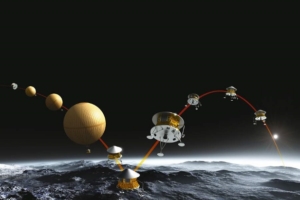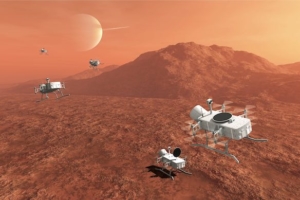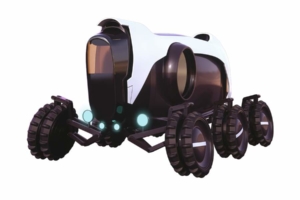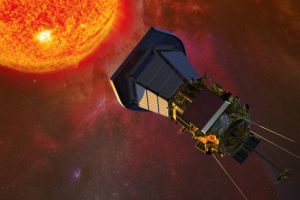A NASA project is working on a new way to slow down planetary spacecraft to enable an ingenious hopping dwarf planet mission
 FutureTech
FutureTech

 FutureTech
FutureTech
A NASA project is working on a new way to slow down planetary spacecraft to enable an ingenious hopping dwarf planet mission
 FutureTech
FutureTech
NASA’s innovative proposal to send a robotic dragonfly to scout Saturn’s largest moon
 FutureTech
FutureTech
NASA’s art and design outreach projects have produced a stylish Moon rover
 FutureTech
FutureTech
Things are heating up at NASA as Solar Probe Plus prepares to take a plunge into the Sun
[fototag id=”kankohmaru”]
Hover over the icons for more information. Illustration by Adrian Mann.
Sometimes when we envision the future of space exploration, we like to let our imagination get the better of ourselves. Today we’re seeing a new breed of rockets and space vehicles that are increasing our ability to access space like never before.
So when we come across a design like the Kankoh-maru, even though it’s blatantly obvious we won’t be seeing anything of the sort flying in our lifetimes, there’s no harm in dreaming of a future where such vehicles are commonplace, right?
The Kankoh-maru, as seen above, was a concept devised by the Japanese Rocket Society in 1993. Named after the steam-powered Japanese Kankō Maru warship, this bizarre egg-shaped vehicle would take off and land by itself, known as VTVL (vertical takeoff and landing), as a single-stage-to-orbit (SSTO) spacecraft. The whole thing is reusable and, with each launch, the Kankoh-maru could take 50 people into orbit.
In recent years a variety of tests on VTVL vehicles have been carried out, most notably SpaceX’s Grasshopper rocket, but nothing on the scale of the Kankoh-maru has ever really been considered, let alone tested.
Nonetheless, the design of the Kankoh-maru is certainly intriguing. This vehicle, weighing about 550 metric tons (1,200,000 pounds), would tower 23.5 metres (77 feet) above the ground and have a diameter at its base of 18 metres (59 feet).
The spacecraft is split into two sections, with a propulsion section at the bottom using four boosters and eight sustainer rockets providing thrust at sea level and in space respectively. Above the propulsion section is the payload section, with the cockpit sitting at the very top.
The purpose of this spacecraft would be to take a large number of crew into Earth orbit, either to a orbiting space hotel or just for short orbital trips. The ambitious goals of the spacecraft would see 700,000 passengers a year being taken into space via a fleet of 52 Kankoh-marus with a ticket price of $25,000 (£16,000) a head. Each of the 52 vehicles would be expected to fly 300 flights a year.
Maybe one day vehicles such as this will regularly take paying customers into space, offering extended stays on orbiting hotels or acting as the first leg of a journey to a futuristic lunar colony. Who knows. For now, we’ll simply have to imagine what could come to pass in a future where space travel is accessible to all, and the Kankoh-maru certainly fits the bill of affording that accessibility even if it is, you know, somewhat ambitious in its design.
You can follow Jonathan on Twitter @Astro_Jonny
The Kankoh-maru is a reusable spacecraft that would be capable of taking 50 people to and from orbit – if it can even be built, that is.
[fototag id=”ganymedeland”]
Scroll over the icons for more information. Illustration by Adrian Mann.
Around Jupiter lurks Ganymede, one of the four Galilean moons and the largest natural satellite in the Solar System. In fact, with a diameter of about 5,270 kilometres (3,275 miles), it is larger even than the planet Mercury and has almost twice the mass of Earth’s Moon.
However, it is not the size of Ganymede that is of most interest. This giant moon, 640 million kilometres (400 million miles) from Earth, has an icy surface and might be hiding a saltwater ocean underground, while its atmosphere bears tantalising hints of oxygen and may even possess a thin ozone layer. For these reasons it has garnered a lot of interest for future exploration missions and one of those, Russia’s Ganymede Lander, could touch down on the surface in the next 20 years.
The Ganymede Lander would launch along with the European Space Agency’s Juipter Icy Moon Explorer (JUICE) spacecraft in 2022, arriving at Jupiter around 2030 after using gravitational assists to reach the giant planet. The collaboration would allow JUICE to scour Ganymede for a suitable landing site for the lander, although a separate Russian orbiter might also join the launch to provide a back-up option to find a landing site.
The lander itself would be a stationary vehicle, touching down on a region of interest on Ganymede to perform scientific analysis. A large antenna on the top would communicate with Earth, while numerous instruments including cameras and spectrometers would analyse the surrounding area. The main focus of the mission would be astrobiology.
This would be the first such mission ever attempted in the Jovian system. So far spacecraft have landed on Venus, the Moon, Mars and Saturn’s moon Titan; landing on Ganymede would mark the sixth body in the Solar System (including Earth) that humanity has left its mark upon.
The Ganymede Lander is still in a concept stage at the moment. Russia will spend up to $1 million (£650,000) on research and development for the spacecraft in 2014 to determine the feasibility of such a mission, with construction on the first prototypes to begin in 2017 if all goes to plan.
You can follow Jonathan on Twitter @Astro_Jonny
Take a look at Russia’s plan to land a spacecraft on the largest moon in the Solar System.